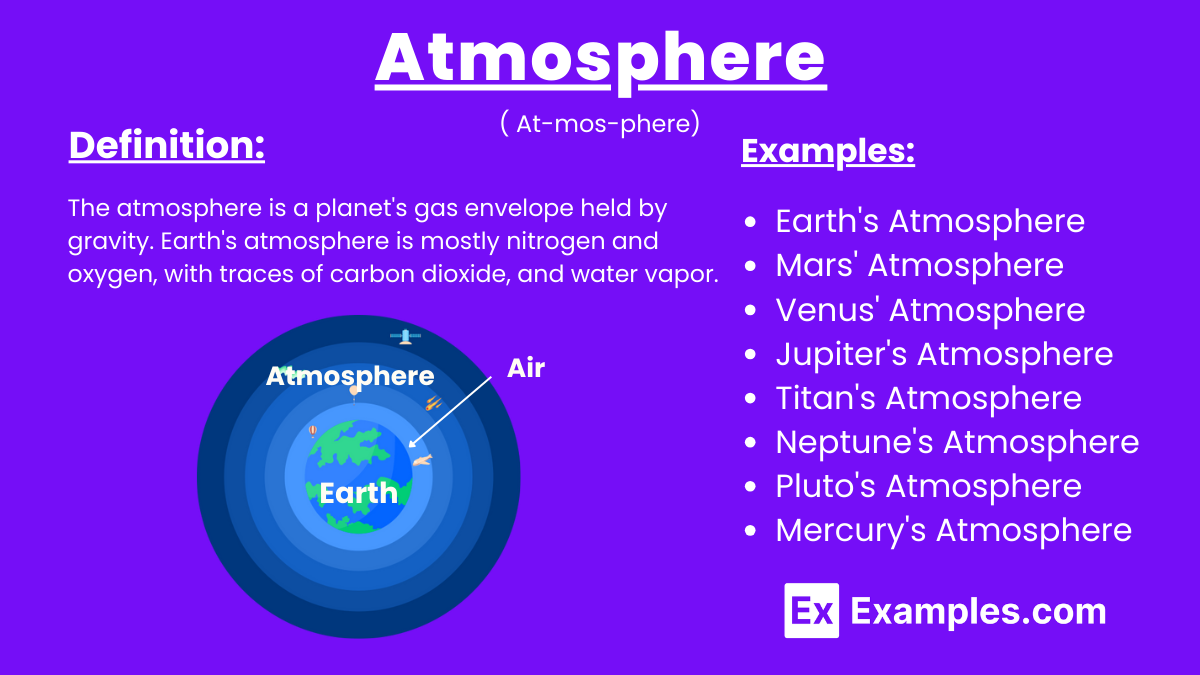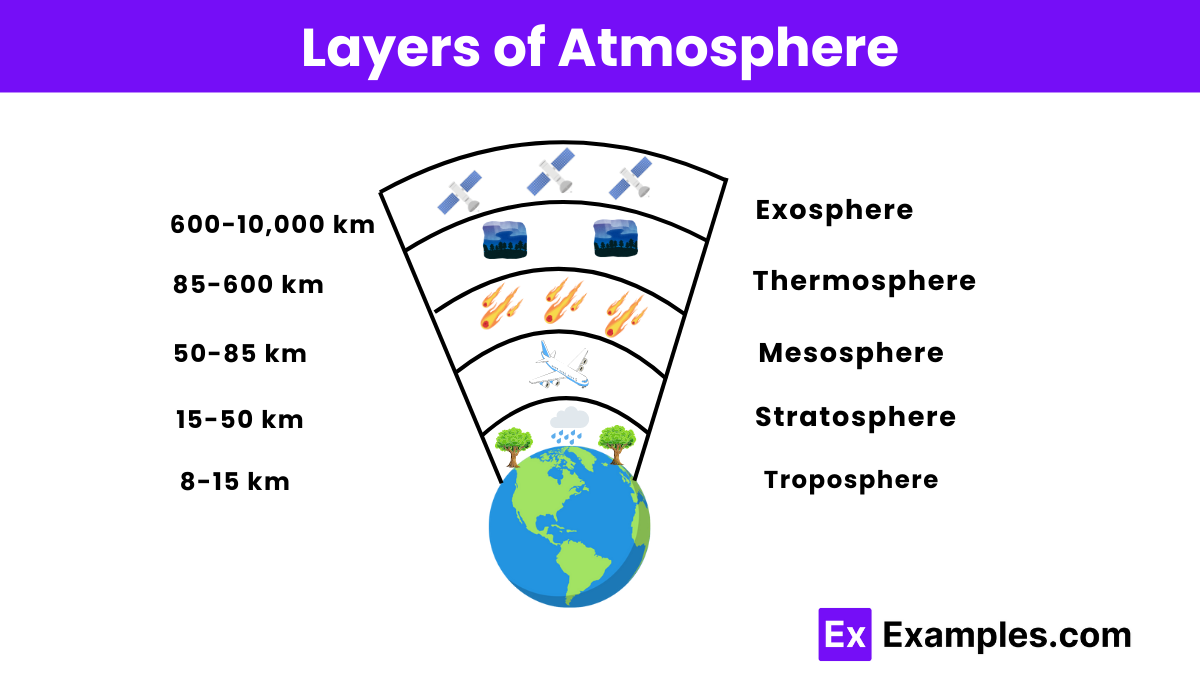What is the primary gas found in the Earth's atmosphere?
Oxygen
Nitrogen
Carbon Dioxide
Argon


The atmosphere is a layer of gases surrounding a planet, held by gravity. Earth’s atmosphere consists mainly of nitrogen (78%) and oxygen (21%), with traces of other gases. It protects life by absorbing solar radiation, regulating temperature, and providing essential elements for life. The atmosphere has distinct layers: the troposphere, stratosphere, mesosphere, thermosphere, and exosphere.
The atmosphere is the envelope of gases surrounding a planet, held by gravity, which for Earth includes primarily nitrogen and oxygen, along with trace amounts of other gases such as argon, carbon dioxide, and water vapor. It plays a crucial role in protecting life by regulating temperature, filtering harmful solar radiation, and enabling weather patterns and climate.

The Earth’s atmosphere is divided into several distinct layers, each with its own unique characteristics:
The troposphere is the lowest layer of the atmosphere, extending from the Earth’s surface up to about 8-15 kilometers (5-9 miles) high. It contains about 75% of the atmosphere’s mass and 99% of its water vapor and aerosols. This layer is where weather phenomena like clouds, rain, and storms occur. The temperature decreases with altitude in the troposphere, and it is the densest layer of the atmosphere, providing the air we breathe.
The stratosphere lies above the troposphere, extending from about 15 kilometers (9 miles) to 50 kilometers (31 miles) high. It contains the ozone layer, which absorbs and scatters ultraviolet solar radiation, protecting living organisms from harmful UV rays. Unlike the troposphere, the temperature in the stratosphere increases with altitude due to the absorption of radiation by ozone. This temperature inversion creates a stable atmospheric layer, which is why commercial jet aircraft typically fly in the lower stratosphere to avoid turbulence.
Above the stratosphere is the mesosphere, which extends from about 50 kilometers (31 miles) to 85 kilometers (53 miles) high. The temperature decreases with altitude in this layer, making it the coldest layer of the atmosphere. Meteors entering the Earth’s atmosphere burn up in the mesosphere, creating the phenomenon known as shooting stars. Despite its thin air, the mesosphere plays a crucial role in dissipating the energy of meteoroids before they reach the Earth’s surface.
The thermosphere is the layer above the mesosphere, extending from about 85 kilometers (53 miles) to 600 kilometers (373 miles) high. Temperatures in the thermosphere increase significantly with altitude due to the absorption of high-energy X-rays and ultraviolet radiation from the sun. This layer is where the auroras, or northern and southern lights, occur. The thermosphere also contains the ionosphere, a sublayer rich in charged particles that is vital for radio communication and GPS signals.
The exosphere is the outermost layer of the atmosphere, extending from about 600 kilometers (373 miles) to 10,000 kilometers (6,200 miles) high. It gradually fades into the vacuum of space and contains very sparse particles of hydrogen and helium. The exosphere is where many satellites orbit the Earth, as it offers minimal atmospheric drag. This layer marks the transition between the Earth’s atmosphere and outer space.
| Layer | Altitude | Features |
|---|---|---|
| Troposphere | Up to 8-15 km (5-9 miles) | Contains 75% of atmospheric mass and 99% of water vapor. Weather occurs here. Temperature decreases with altitude. |
| Stratosphere | 15-50 km (9-31 miles) | Contains the ozone layer, absorbs UV radiation. Temperature increases with altitude. Stable layer where jets fly. |
| Mesosphere | 50-85 km (31-53 miles) | Coldest layer. Meteors burn up here, creating shooting stars. Temperature decreases with altitude. |
| Thermosphere | 85-600 km (53-373 miles) | Temperatures increase with altitude. Contains the ionosphere and auroras. Important for radio communication. |
| Exosphere | 600-10,000 km (373-6,200 miles) | Outermost layer, transitioning into space. Contains sparse particles. Satellites orbit here. |
| Component | Percentage | Description |
|---|---|---|
| Nitrogen | 78% | The most abundant gas, relatively inert, crucial in the nitrogen cycle. |
| Oxygen | 21% | Vital for respiration in most living organisms. |
| Argon | 0.93% | A chemically inert noble gas. |
| Carbon Dioxide | 0.04% | Essential for photosynthesis and a significant greenhouse gas. |
| Water Vapor | 0% to 4% | Crucial for weather and climate patterns. |
| Cloud Formation | N/A | Process involving water vapor leading to cloud creation. |
The composition of atmosphere includes 78% nitrogen, 21% oxygen, and trace amounts of argon, carbon dioxide, and water vapor. These gases are vital for various atmospheric processes like cloud formation and weather patterns.
Air composition properties influence humidity, the amount of water vapor in the air, affecting precipitation and climate. An anemometer measures wind speed and direction, helping to understand different types of wind, from breezes to gales.
Knowing how to make a windmill is practical for harnessing wind energy, showcasing a sustainable use of natural resources. Understanding the atmosphere’s composition and properties is key to studying Earth’s weather and climate systems.
The atmosphere has several key features that are essential for sustaining life and shaping our planet’s climate:
The atmosphere primarily contains nitrogen (78%), oxygen (21%), argon (0.93%), and trace amounts of other gases, including carbon dioxide and water vapor.
The ozone layer, located in the stratosphere, absorbs and scatters ultraviolet radiation, protecting living organisms from harmful UV rays.
The atmosphere regulates temperature through the greenhouse effect, where gases trap heat, maintaining Earth’s climate within a habitable range.
Weather occurs in the troposphere due to the interaction of heat from the sun, moisture, and wind, creating various weather patterns and phenomena.
Atmospheric pressure decreases with increasing altitude because the density of air molecules decreases as the distance from Earth’s surface increases.
The greenhouse effect is the process where certain gases in the atmosphere trap heat from the sun, warming the Earth’s surface.
Nitrogen is essential for living organisms as it is a key component of amino acids, proteins, and DNA, crucial for life processes.
The atmosphere is vital in the water cycle, facilitating processes like evaporation, condensation, and precipitation, distributing water globally.
Human activities, such as burning fossil fuels and deforestation, release greenhouse gases, contributing to global warming and climate change.
Atmospheric pressure is the force exerted by the weight of air in the atmosphere on Earth’s surface, measured in units like pascals or millibars.
Text prompt
Add Tone
10 Examples of Public speaking
20 Examples of Gas lighting
What is the primary gas found in the Earth's atmosphere?
Oxygen
Nitrogen
Carbon Dioxide
Argon
Which layer of the atmosphere is closest to the Earth's surface?
Stratosphere
Thermosphere
Mesosphere
Troposphere
What is the main function of the ozone layer?
To regulate temperature
To produce oxygen
To facilitate weather patterns
To block harmful UV radiation
In which layer of the atmosphere do most commercial jets fly?
Troposphere
Stratosphere
Mesosphere
Thermosphere
What phenomenon occurs in the mesosphere?
Auroras
Weather events
Meteor burns up
Temperature increase with altitude
Which layer of the atmosphere contains the International Space Station?
Troposphere
Stratosphere
Thermosphere
Exosphere
What is the primary source of energy for atmospheric processes?
Geothermal energy
Solar energy
Nuclear energy
Chemical energy
Which gas is known as a greenhouse gas that contributes to global warming?
Oxygen
Nitrogen
Methane
Neon
What is the term for the boundary between the troposphere and the stratosphere?
Tropopause
Stratopause
Mesopause
Thermopause
Which layer of the atmosphere is characterized by a decrease in temperature with altitude?
Troposphere
Stratosphere
Mesosphere
Exosphere
Before you leave, take our quick quiz to enhance your learning!

